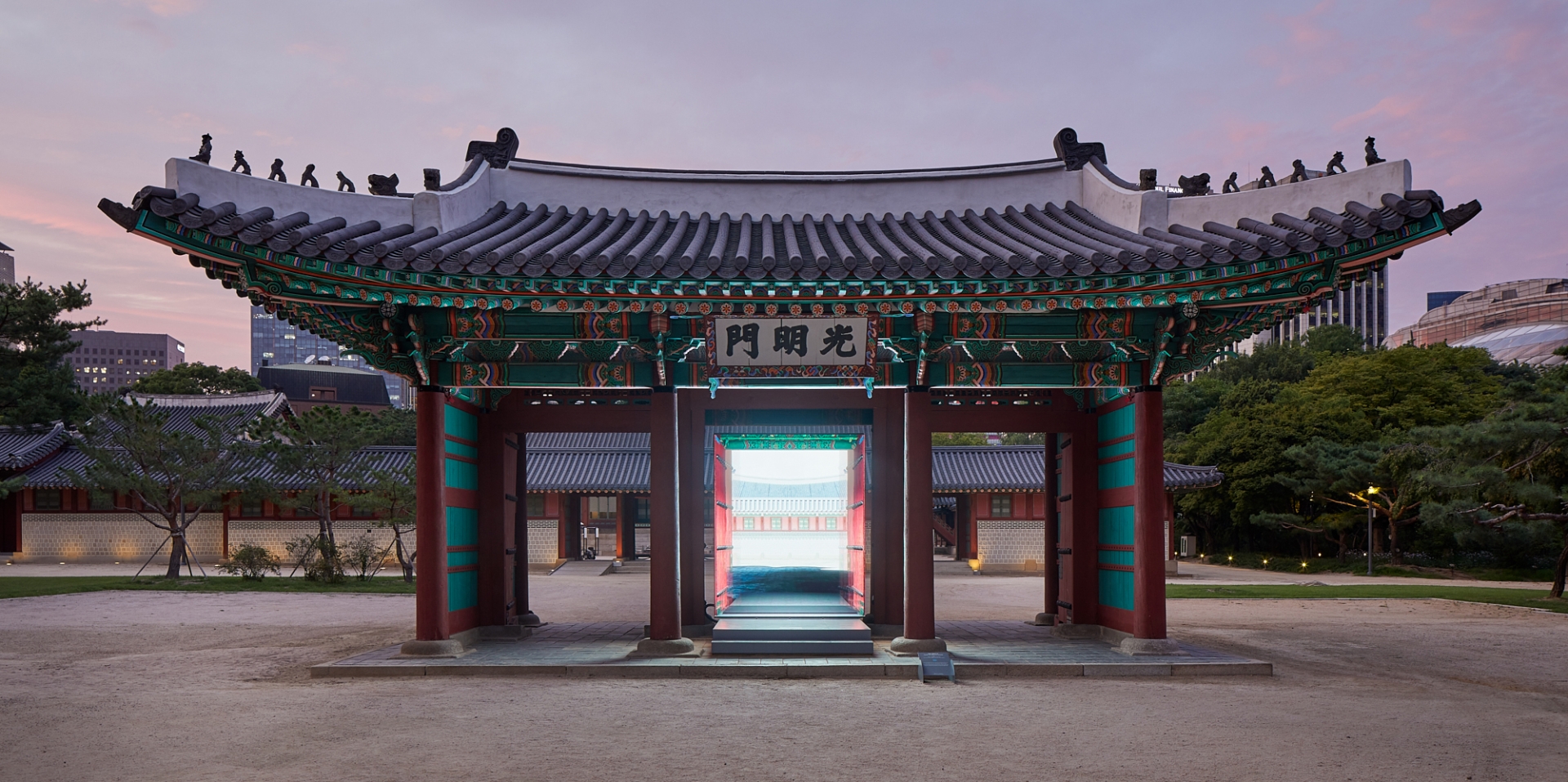‘Architecture and Heritage: Unearthing Future’ is an exhibition which aims to observe the contemporary significance of Deoksugung Palace as a modern heritage site, aligning itself with the ‘Deoksugung projects’ which took place in 2012 and 2017. Unlike these precursors, which involved only domestic artists, five domestic and international architect teams participated this year, including Space Popular, CL3, Bureau Spectacular, OBBA and Obra Architects. Lee Jihoi (curator, MMCA) remarked that the exhibition ‘focused on keywords such as “the opening of ports,” and “modernization” in the history of Deoksugung’, and that ‘architects who are currently active in other Asian regions were invited to create installation works based on spatial experiences’.
Five Perspectives Illuminating Deoksugung
First, the team OBBA (Kwak Sangjoon, Lee Sojung) erected a Daehan Yeonhyang at the centre of the Junghwajeon Hall courtyard. The team focused on the celebratory court banquet (yeonhyang) that would have been held for the 40th anniversary of emperor Gojong’s succession to the throne, which would have taken place on the same site in 1902, by reinterpreting the sun screens used at the time. Cylindrical structures were installed, upon which were hung drapes attached to colourful reflective film. OBBA remarked that, ‘at the time, the event became the last court banquet of the Daehan Empire, and we felt that it would have been marked more with a sense of sadness and apprehension about an uncertain future than with a sense of joy. We wished to transform the banquet into an event of joy.’ Also, they used ‘colourful reflective film with its dual qualities as a means to highlight confrontation and conflict’, such as the fact that Deoksugung is ‘currently surrounded by high-rise buildings, while wooden buildings and modern stone buildings can be found facing each other on the inside’. The drapes of the Daehan Yeonhyang sway, scattering colour to the wind and letting the sunlight stream through them.
In the evening, the drapes especially catch the light and choreograph a dreamlike yeonhyang scene in the courtyard of the Junghwajeon, transfixing the gaze of visitors. The project is the most evocative of the five projects on show.
Bureau Spectacular (Jimenez Lai) concentrated on evoking a sense of time in the space. Future Archeologist, installed in front of the Seokjojeon fountain, is a work which transfers the relationship between the past and the present, the present and the future to ground level. Lai was inspired to create this project following an article he read which stated that the soil and dust left to naturally accumulate will pile up to 3mm high on ground level each year. It was imagined that a thousand years later, a future archeologist might be able to excavate the present Deoksugung from a position 3m higher than today.
Bureau Spectacular explained that, ‘this structure, which permits an experience of the palace from a novel point of view, is a representation of the modern landscape seen from above. Motifs were drawn from the Dom-Ino system proposed by Le Corbusier.’ Future Archeologist was originally realised as a structure that would mount endlessly. It was proposed on a spectacular scale, but following negotiations with the administration it was completed at its current height of 7m. While the architects point of investigation was not fully realised, the structure permits one to look down on Deoksugung from an unprecedented height.
Perpetual Spring by OBRA Architects (Jennifer Lee, Pablo Castro) has emerged in the courtyard of the MMCA Seoul away from Deoksugung. This ‘greenhouse’ pavilion with an iron-core structure of 15m wide and 7.6m high, with an attached transparent hemisphere, is a project which actively reinterprets and propels the historical fact that the ‘state funeral of the Emperor Gojong’ march which started in Deoksugung became an ignition point for the March 1st Movement. The architects explained that they ‘referenced the fact that the climate conditions for spring could have become the background for historical events promoting more liberal societies, such as the March 1st Movement and the Gwangju Uprising in South Korea, and that the season of spring was activated as a poetic metaphor for events like Prague Spring or Arab Spring’. They also revealed their ‘hopes that these thoughts could be developed to better communicate the issue of climate change which has emerged as a pressing global issue today’.
The Perpetual Spring which integrates solar panels, exhaust fans, aluminum foil curtains, and ondol system provides an internal space which can be used comfortably even in the winter. The audience can freely use this space to socialize or hold meetings.
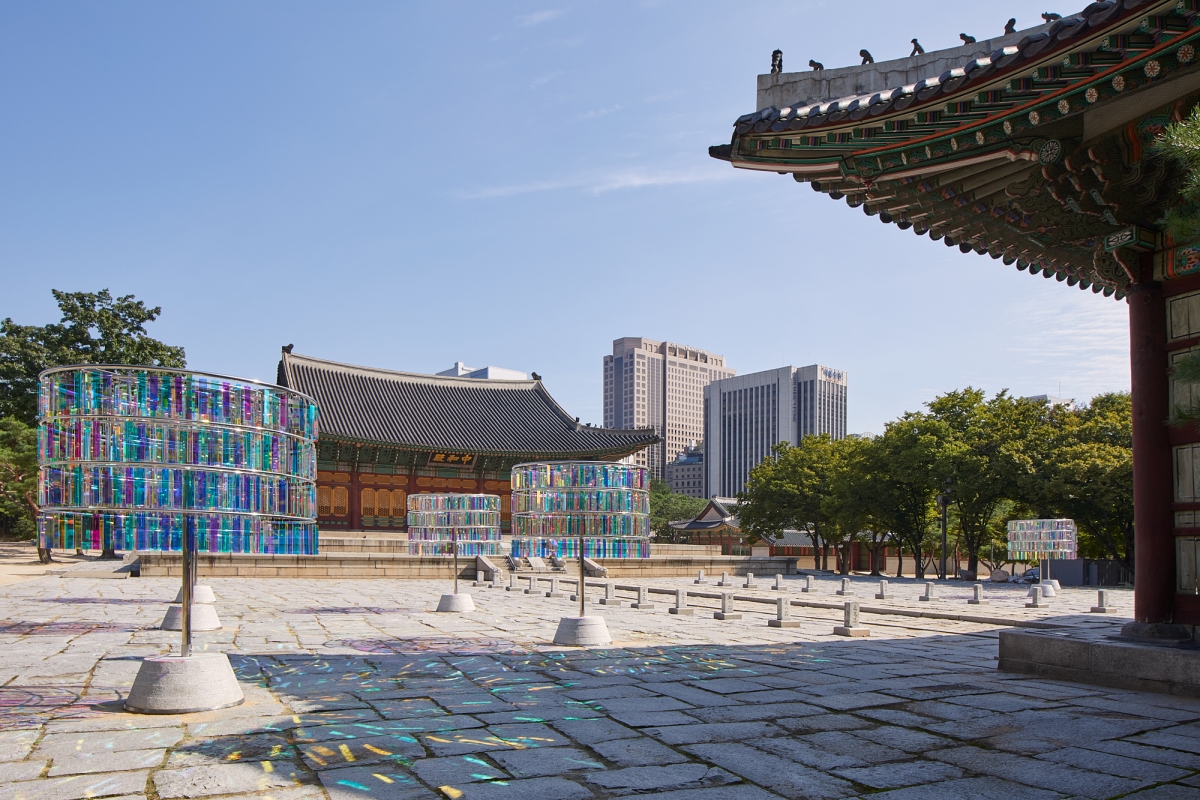
Daehan Yeonhyang, OBBA
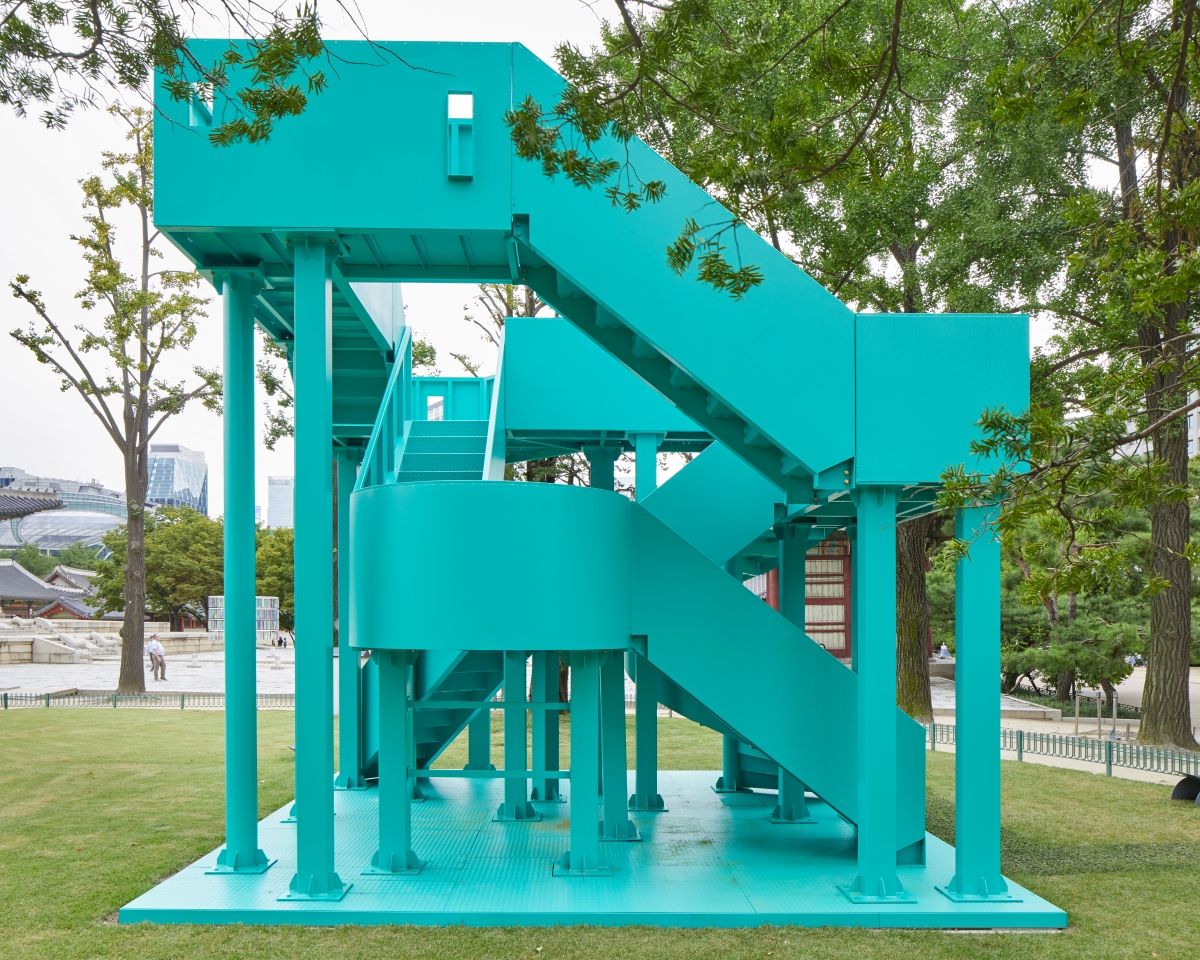
Future Archeologist, Bureau Spectacular
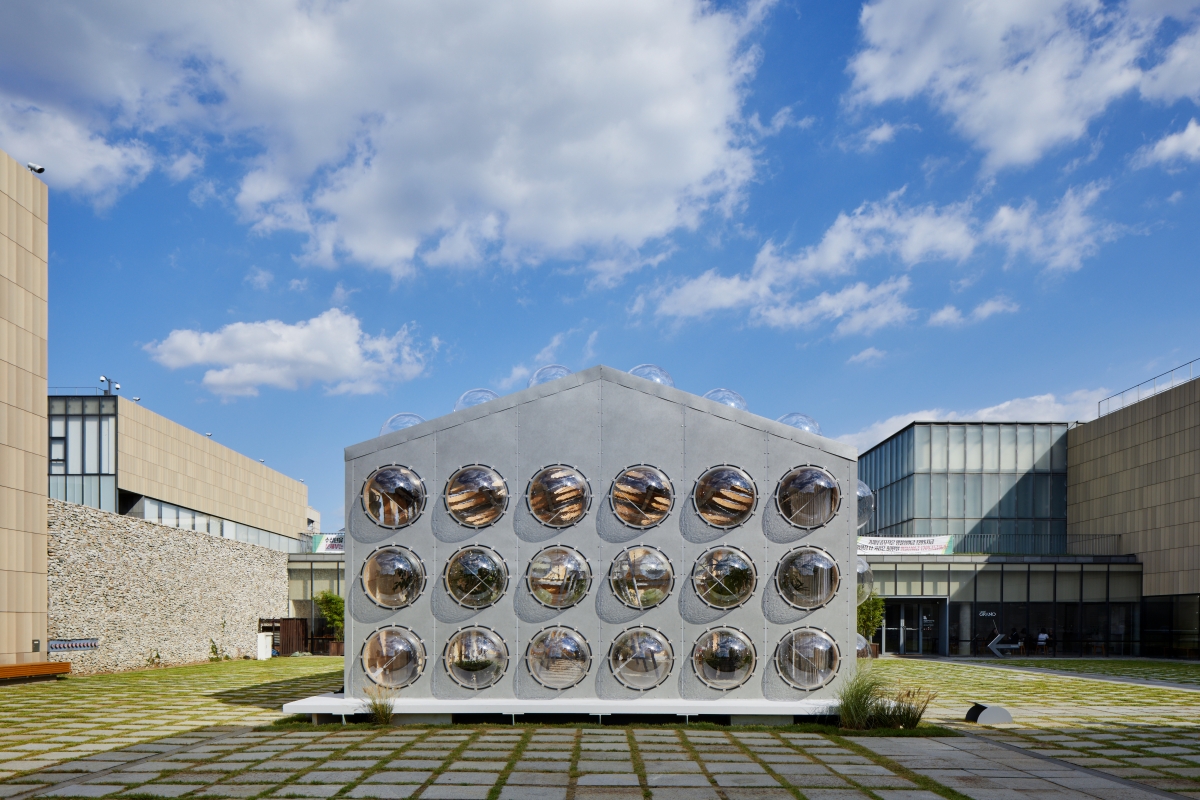
Perpetual Spring, OBRA Architects
Heritage as a Tool to Diagnose the Present
On the 5th of September, the Deoksugung seminar room of the MMCA hosted the ‘Architect Talks’ as an associated exhibition event. The first of these meetings on this day was conducted by Space Popular (Lara Lesmes, Fredrik Hellberg) and CL3 (William Lim), with Gabriele Mastrigli (professor, University of Camerino), who wrote the catalogue essay, to discuss the projects and the concept of ‘heritage’ which underlies these projects.
First, Space Popular described their project Gate of Bright Lights. This project involved the installation of a large-scale LED screen at the entrance to the Gwangmyeongmun Gate of Deoksugung, and the resulting structure, which resembles an augmented version of a smartphone screen, which was supported by an intensive period of research. Space Popular first questioned, ‘What do we choose to be preserved as a heritage site?’ and then responded that ‘in the same way that dancheong is recognised as an architectural element in ancient Korean architecture, we think that perhaps the LED panels overlaid on today’s architecture might, in the far off future, be recognised as the heritage of today’. They added that they ‘decided to propose the project installing a virtual photowall in Gwnamyeongmun Gate as a way of connecting the past and the present in Korea, which is seen as the world’s leading manufacturer of LED panels’.
Space Popular also discussed the relationship between architecture and virtual space. According to them, currently, the doors which guide us to important spaces are virtual portals like that of the smartphone screen. While we continuously visit and exit disparate worlds, we do not recognise the significance of such experiences. Virtual space, like architecture provides holistic ‘experiences’, at times altering our sense of identity. Space Popular asserted that ‘the question of traversing the realms of reality and the virtual is not only an existentialist conundrum, it is also an important question to be investigated by architecture’, adding that ‘the perspective from which it symbolises authority, architecture which plays the role of “media” has leased its role to many different machines (media) in the digital age, and we attempted to investigate the role and function of architecture throughout this epoch in our work’.
CL3 introduced Furniture for an Emperor in Transition to the forum, installed at the Hamnyeongjeon Hall of Deoksugung as an extension of their former architectural projects. It can be moved by the audience due to the wheels that are attached to the lower body of the structure as a form of furniture. He explained that it was a ‘project which shares its approach with the architectural projects carried out so far’ in the sense that it motivates users to behave in certain ways through inserting new spaces in the existing urban environment. CL3 emphasised the fact that the original function of the Hamnyeongjeon Hall as a place of discussing domestic affairs had been modified to that of a bedroom.
He noted that ‘While we consider the city, empire, etc. to be in a stable and continuous state, cities in modern society are closely related to the concepts of movement, migration, transition’, and that ‘the history of the Hamnyeongjeon Hall and the use of its space could also infer such concepts’. He deciphered the furniture of the emperor’s domain of the Daehan Empire through many different archives and photographic materials. He integrated this with the modern furniture he had researched from the 20th century. CL3 added that he ‘wished that visitors could sit themselves on the furniture to imagine daily reality for the emperor at a time lively with the meeting between East and West’.
Finally, the architecture critic Gabriele Mastrigli discussed the keyword behind this exhibition, ‘heritage’. According to him, from a western point of view, heritage and modernisation can be recognised as opposing concepts. However, in the case of Seoul, he found that the two were closely connected. Mastrigli pointed out that ‘excavation is a modern concept, by which something is destroyed to uncover something else, and heritage, as the result of excavation, is always inherently accompanied by a process of selection and elimination’. He continued his discussion by featuring sketches and photographs of the Plan Voisin by Le Corbusier. Mastrigli asserted that ‘Le Corbusier’s proposal was to select whatever would serve as a monument to the past, rather than demolishing the existing urban structure, and to make this selection function in association with the newly constructed city’, adding that ‘the leftover monuments would serve as a “machine” to provide a grammar to create a new architecture, as well as an object which was constantly being reinterpreted’. Moreover, ‘these structures were not simply icons, they incited certain choreographed movement within the city as a “machine” and associated meaning to such movement’. To support this opinion, he showed the audience photographs which Le Corbusier would have taken of the Ancient Greek temples with a camera the size of a person. He explained that he was the first architect to have analytically observed architecture in a way similar to our contemporaries.
Finally, Mastrigli explained that ‘in this exhibition, the projects pursue certain concepts, rather than simply dealing with the heritage of the past, and here heritage is applied as a powerful critical device through which to peer into the future’, concluding that ‘these projects tell us the story of how we move, as well as how we might observe and understand space’.
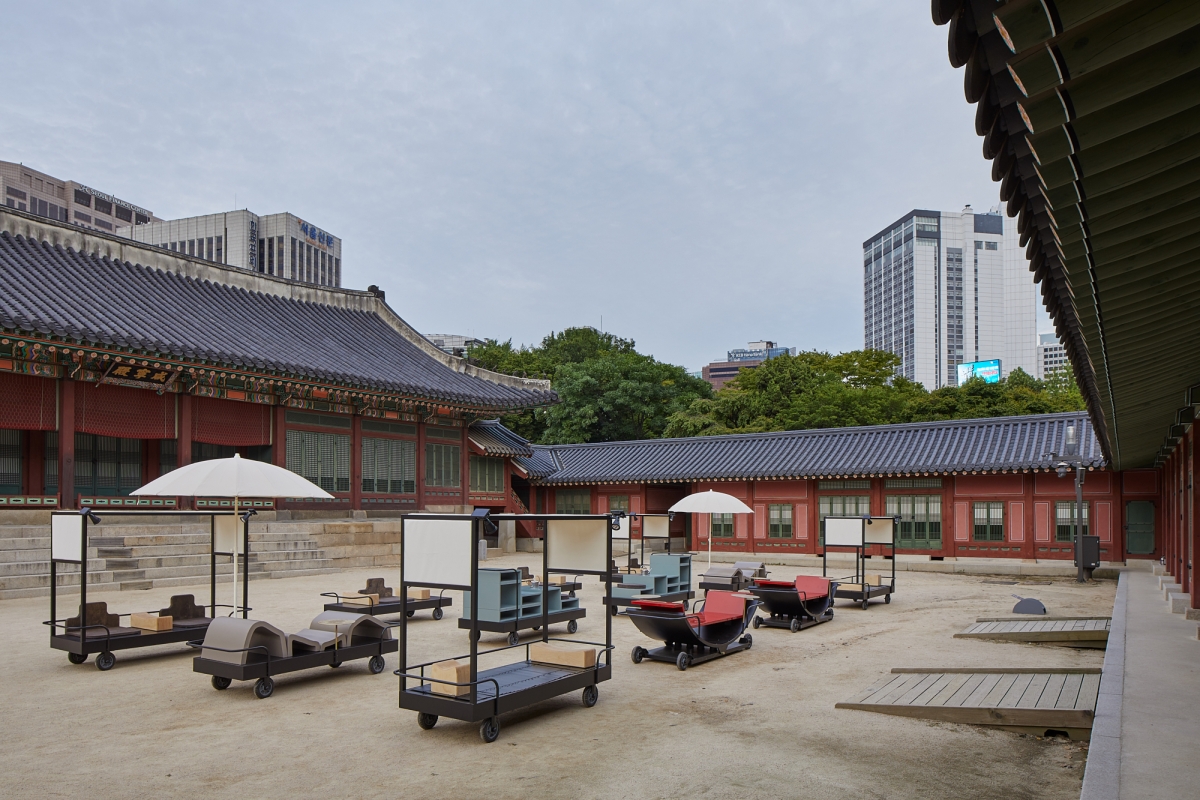
Furniture for an Emperor in Transition, CL3
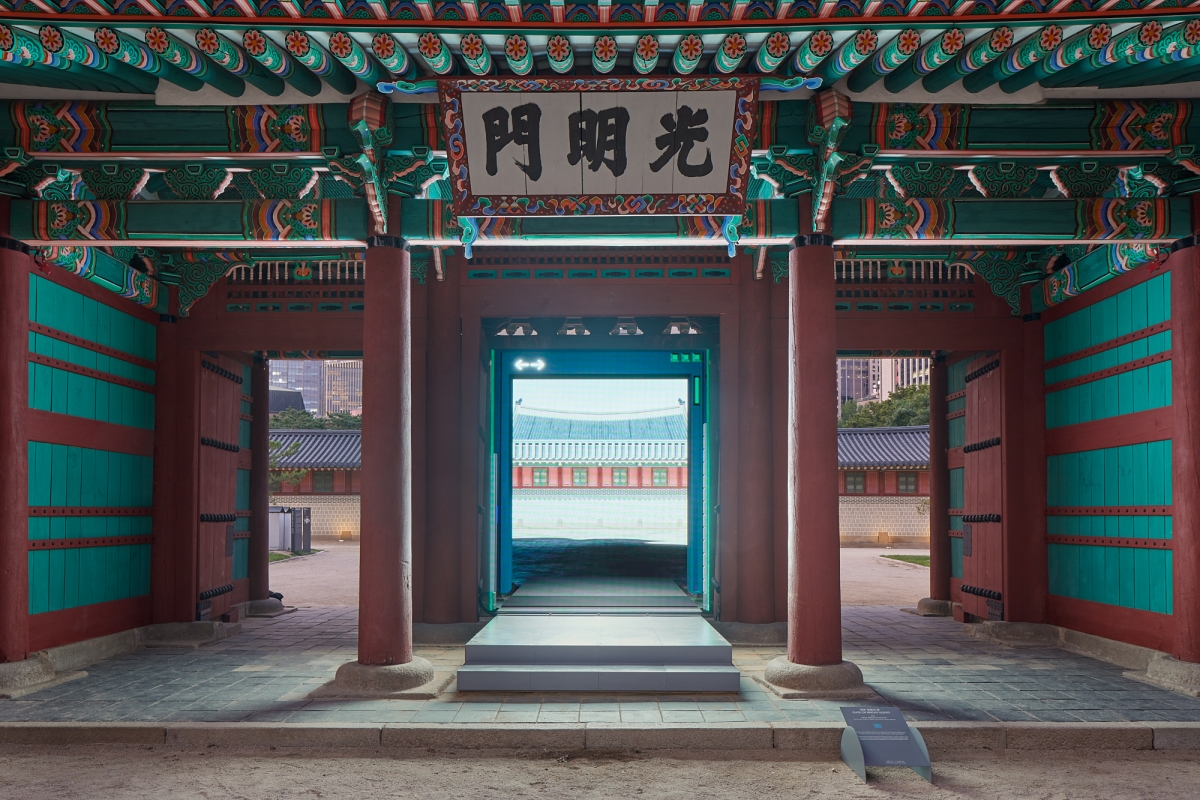
Gate of Bright Lights, Space Popular





